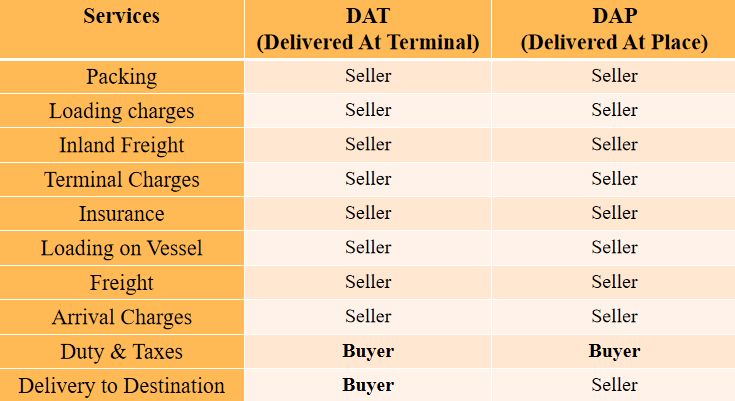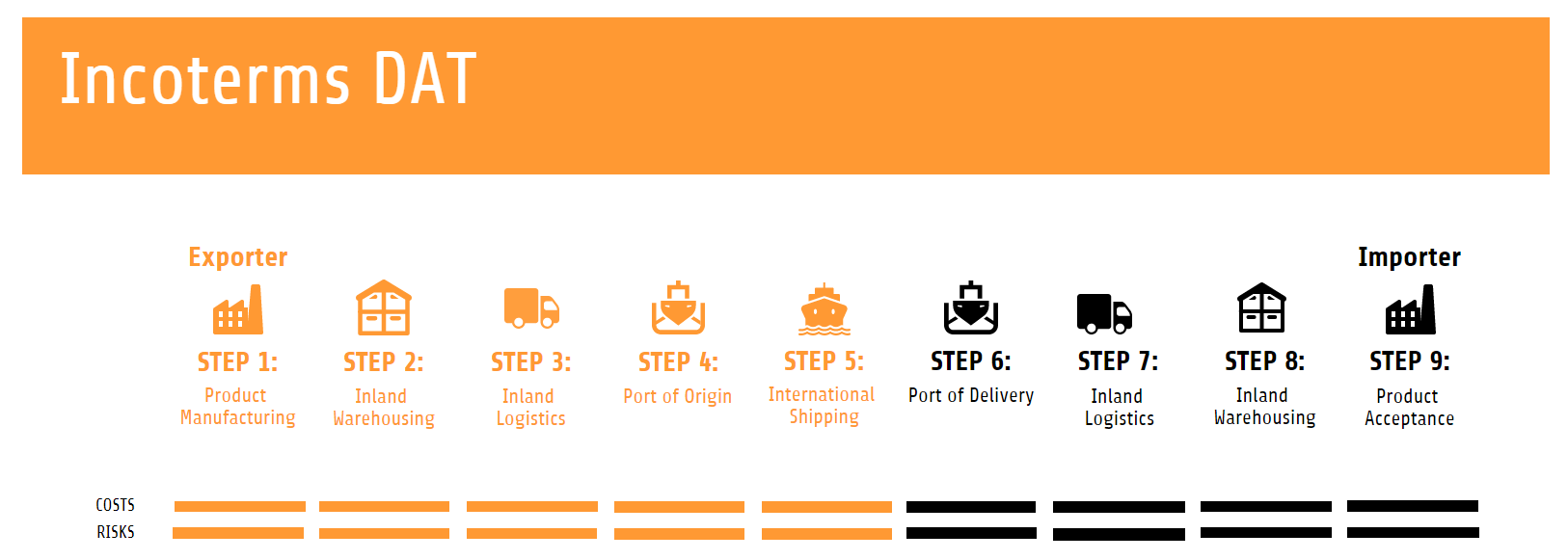International Commercial Terms (Incoterms) are pre-determined trade terms of ICC (the International Chamber of Commerce) to describe the mode of delivery of goods and the roles of importers and exporters in the process. Both buyers and sellers in the global trading market should acknowledge them during the transaction.
As one of the Incoterms, DAT used to be referred to as DES (Delivery at Ship) and DEQ (Delivery at Quay) in the year 2000. However, effective from January 2020, DAT has been renamed to DPU, i.e. Delivery at Place Unloaded.
However, the changes were only made to capture the full essence of the term as accurately as possible. Thus, the terms of the agreement are still binding.
How does DAT work?
Transaction under the DAT term implies that the seller will deliver the goods to a location or terminal, such as a port, a quay, container yard, warehouse road transport hub, etc. Both the seller and the buyer should previously determine and establish the terminal in the agreement.
And after the delivery, the buyer will take up full responsibility for the goods, including sorting out the import formalities and inland logistics.
In this process, the seller covers the costs and expenses before delivery, including bills relating to terminal handling charges, while the buyers pay for the cost after the delivery, like customs duties, clearance, taxes, and transportation from the endpoint to other places.
As there is a transfer of all liabilities on the goods from the seller to the buyer at the endpoint, it is essential that both parties agree upon the delivery point and state it clearly in the agreement.
In addition, DAT has certain similarities and salient differences with and from other incoterms, including DAP and DPP as will be touched on subsequently to help aid understanding.
Case Study
A Canadian buyer buys automobile spare parts from China and the parts will be transported under ‘DAT’ to a facility at the terminal in Canada.
In this case, the Chinese clear the spare parts through customs at the China port, and take care of the bills covering the cost of carriage and insurance up until safe delivery in Canada.
After successful unloading at the Canadian port facility, the responsibility and risks are duly transferred to the Canadian buyer. He will see to the completion of the delivery process.

What are the peculiarities of DAT?
- Sellers or suppliers take up responsibility for the transport of goods from origin to destination.
- The importer or buyer handles the importation charges and transportation to the intended location.
- There is a transfer of risks and liabilities from supplier to importer upon delivery at the port/terminal of destination.
Advantage and drawback of DAT for buyers
Buyers are assured of getting their goods delivered at the agreed spot and can concern themselves with other clearing and forwarding. But correspondingly, they have to bear the risk of potential damage/loss when reloading and onward forwarding to the final destination.
Advantage and drawback of DAT for sellers
Sellers only have the responsibility of getting the goods to the port, which makes the difficulty levels considerably low. But it is also possible that the buyers do not comply with the terms of the agreement and fail to take delivery of the goods.
What are sellers' obligations under DAT?
1. Licensing
As a seller, you should try to obtain and provide the local authorities in the country of origin with the export licenses or authorization upon request. These documents permit legal export and will help avoid any challenges that might impede the process and cause a failure to meet up with the demands of the arrangement with the importer.
2. Delivery and unloading of goods
This is the most obvious and crucial duty for sellers. You must deliver and unload goods at the agreed location and time with the necessary documentation, including invoices or their equivalents and proof of delivery (a document that allows the buyer to pick up goods) for a smooth delivery process. You should prepare to do so.
3. Transportation and insurance
For a seller, getting the goods across to the destination goes without saying as a vital role. They should consider various modalities and choose the most cost-effective one.
In cases of accidents, fire outbreaks, losses on the high sea, attacks by sea pirates, etc., insurance policies in place for a buyer help cushion the effects of the mishaps. You should make plans for those.
4. Costs (fee and levies)
It’s your duty to handle all costs of the goods relating to transport (contract of carriage), loading at the place of origin, export clearance at origin, unloading at the destination, etc.
5. Notice to buyer
A notice indicating safe delivery of the goods at the designated destination should be served to the importer or buyer.
This notice functions as proof of compliance with the terms of the agreement on the part of the supplier, a reminder of the deal and it effectively signals the end of the exporter’s input.
6. Checking
Also, you should assess the goods for quality control and assurances, measurements, counting, packaging, and tagging to ensure that you can deliver all items in good shape.
What are buyers' obligations under DAT?
1. Payment
As a buyer, you need to make the payment as predetermined in the contract between you and the seller. It covers all fees and levies including importation, custom duties, and taxes.
2. Licenses, authorization, and formalities
Buyers should obtain export licenses, import permits, and the necessary documentation to expedite the delivery process. Please be ready to do so too.
3. Shipping and insurance
Though the suppliers will cover these, as a buyer, you’d better monitor it anyway to keep all involved on your toes and to step in when the situation requires it.
4. Taking delivery
This is the most obvious of the duties, is so crucial, and should be at the preferred location and time. You should make sure you are available for this.
5. Transfer of risks
The buyer will take up responsibility for risks and liabilities in cases of loss or damage once the goods are offloaded at the terminal. You should make arrangements for this.
6. Notice to the seller
Reciprocally, as an importer, you should send a notification to the supplier, acknowledging receipt of the goods, detailing the time of shipment arrival, and further validating the proof of delivery from the exporter. Also, you should do the inspection, pre-shipment, and upon delivery.
What's the difference between DAT vs DAP?
The Delivered at Place (DAP) incoterm is also an agreement between the supplier and buyer. DAP means that the supplier commits to handling all costs of transporting the goods to a named destination (outside the terminal) including fees for:
- Packaging
- Documentation
- Loading charges
- Insurance
- Onward transit
| DAT | DAP |
|---|---|
| Delivery point is the port or terminal | Delivery point is a named location outside the facility |
| Losses are covered by the seller before delivery and the buyer afterwards. | Losses are covered by the seller |
Thus, compared with DAT, the prominent difference is in the delivery point. DAT is at the port or terminal, while DAP is in a named location outside the facility. That is to say, under DAT, the buyers are responsible for transporting the goods from the delivery terminal to the final destination, while under DAP, they just need to wait for the goods at the destination.

Final words
Above are the basic knowledge about the Incoterm DAT explained, feel free to leave a comment below if you have any questions.
We are Jingsourcing, a leading sourcing company in China, committed to helping business owners import products from China at competitive prices. If you need help in customizing, wholesaling, and shipping your products from China, please don’t hesitate to CONTACT US.


